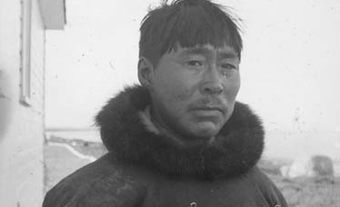Beginning in the mid-1950s, Inuit were encouraged to move into the trading posts to be near schools and medical services. Since they were no longer able to support themselves fully by hunting, federal civil servants established co-operatives to provide wage labour and to serve as a vehicle for the development of a local economy. The Department of Northern Affairs and National Resources made money, equipment and expertise available, but the idea from the beginning was that Inuit would assume management and ownership of the co-ops as soon as possible.
The first Inuit co-operative — based on commercial fishing and logging — was established in April 1959 at George River (now Kangiqsualujjuaq) in Northern Québec. Twenty Inuit hunters became members of this first arctic co-op by virtue of having each purchased a one-dollar share entitling them to one vote at the annual general meeting.
Although Inuit co-operatives are multipurpose, involved in retail stores, hotels, restaurants, tourism, construction projects and the provision of municipal services, their most successful activity has been the production of stone carvings and limited edition prints for sale in an international market (see Inuit Art; Inuit Printmaking). The cottage industry production of stone sculpture is a significant source of income in small northern communities, a felicitous solution to dependence upon a boom-and-bust fur cycle. As Inuk Johnny Pov said, "Carvings rescued all the people from the wretched situation they were in. If they had to rely only on the trading of fox skins, they would undoubtedly still be poor today." In latter years, the retail store operation (and, in Northern Québec, the distribution of petroleum products) has become more important in some co-ops.
Co-ops soon became the largest non-government employers of Indigenous people and an important social movement in the North. They succeeded in raising the living standard in many communities and reduced dependence on welfare. In 1999, there were 39 active co-ops, members of one of two centralized federations: Northern Québec co-ops are members of La Fédération des Coopératives du Nouveau-Québec, based in Montréal; Nunavut and Northwest Territories co-ops are members of Arctic Cooperatives Limited, based in Winnipeg. There are also a few independent co-ops. The Inuit co-op movement, formally begun with the sale of two fish to Stanley Annanack in Kangiqsualujjuaq in 1959, has grown to an annual level of business of more than $83 million dollars (1998-99). Inuit now own the co-operatives, which they run with only modest government financial assistance.
As an alternative economic form, co-ops typically attempt to achieve political power. In Northern Québec, concerted attempts were made to achieve some political leverage; the strategy of the federated co-ops was to take charge of their economic system, then their territory, their education and, finally, their political system. In the 1970s, efforts were made to convince the Québec government to develop a regional form of government for Northern Québec. These did not play out, but Inuit in the territory continue to exert efforts towards a local form of self-government. The Northern Québec co-op system was referred to for several years as an "underground government," but, in the rest of the Arctic, political power was not as assiduously sought. The co-operatives did, however, spark a pan-Inuit movement that was evident at the Iqaluit conference only four years after the first co-op was incorporated. This conference was the first occasion in history on which Inuit from all across the Canadian Arctic had assembled to discuss common problems and make decisions. It was followed by a 1966 conference in Puvirnituq and the 1980 conference at Kangiqsualujjuaq at which the need for unity was stressed. Although some efforts have been made towards pan-Arctic unity, in the main these are not bearing fruit; co-op activities remain divided along provincial and territorial lines.
See also Co-operative Movement.

 Share on Facebook
Share on Facebook Share on X
Share on X Share by Email
Share by Email Share on Google Classroom
Share on Google Classroom






